Some of my favorite pieces by famous artists are unknown. These works have become, for me, like vivid dreams forgotten within seconds of awakening, or photo albums destroyed in a fire. Most are lost treasures which only now exist as JPEGS that people such as myself happen to have downloaded. Not only are these works by Basquiat, Van Gogh, Hirst, Koons, Emin, Duchamp, On Kawara, Paul McCarthy, Christopher Wool, Richard Prince and Jonathan Meese precious gems, they contain an art historical lesson in what is considered quality, what is allowed and what is impermissible.
One painting by Jeff Koons, for example, was simply damaged in an opening when someone spilled champagne on it, and hasn’t reappeared. Other pieces were considered to be in very bad taste, inappropriate, or were taken out of circulation for personal reasons. Here are some works I’ve written about in the past, or have downloaded images of for my personal enjoyment, which have now disappeared from the public eye. I dont think my understanding of art history would be complete without them, therefore I share them as a possible addition to your knowledge of the scope of great art.
Jonathan Meese:
Die Canary

This is a serious loss for Meese fans as not only is it a large-scale painting in his mature, signature style, it includes, as they frequently did, photographs of himself.
This painting was lost at sea when the shipping container it was in fell overboard during a storm and sank. There are suspicions that piracy and collusion may be the real “accident”, and I hope so, because in that case the painting at least still exists somewhere. It is equally likely that it is at the bottom of the ocean. For now Meese’s work is not valuable enough to warrant a search.
Jeff Koons:
1) Arousing Curiosity
I’m not a big fan of Jeff Koons, but sometimes he makes something, like the Balloon Dogs or that giant puppy made of flowers, that are kinda’ hard to resist. You have to pooh-pooh the work in spite of yourself, because while you may object to it on intellectual grounds, you know you like it.

The captivating painting above by Jeff Koons was the irresistible standout in one of his openings, with most people crowding around it to discuss the symbolism of the hot dogs, Casper the Friendly Ghost, and mostly just to take in the overall beauty of the composition, colors, and layering of images. While most Koons’ sculptures are copies of existing pieces, in his paintings he juxtaposed images and gestural brush strokes in a unique way that showed he was not just an appropriationist, but could produce his own original works. Arousing Curiosity was Koons’ best crystallization of his own vision, and proved he wasn’t just a copy-cat.
The magnetic attraction this painting had on opening night backfired when people bumped into each other trying to see what the commotion was about, and someone lost his balance and spilled a full glass of champagne and a plate of shrimp cocktail on the painting (I heard it was art critic Jerry Salz, but that is an uncomfirmed rumor). Something about that chemical cocktail discolored the oil paint and the painting has never reappeared.
Jeff Koons was so proud of this work in particular that he posed in front of it for publicity shots. Significantly, he has not subsequently produced as ambitious of a painting.

Fortunately I wrote an article about Koons’ paintings, and this one in particular about 4 years ago, and it contains the images I grabbed off the internet at the time.
2) Candy Wrapper, Blue
Koons conceived a series of candy wrapper sculptures, but the first one to appear in public didn’t last a week.
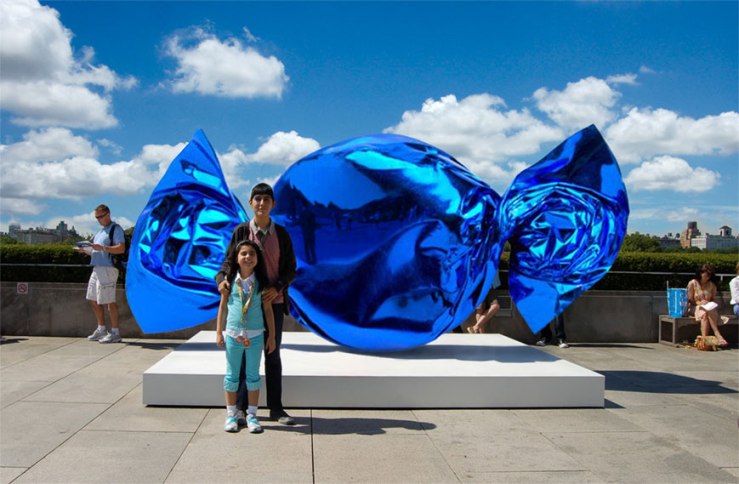
As with his balloon dogs, Koons’ first candy wrapper sculpture showed an exquisite attention to detail, and the folds were a pleasure to behold. Why didn’t Koons run with this and produce another multi-million dollar line of sculptures? There were at least three reasons, only one of which could have been foreseen. The forseeable, and the inevitable, was that the manufacturer of the candies Koons modeled the sculpture on would want a cut. Unlike the balloon dog, in which Koons took an icon for which there was no known author, and additionally modified the physical object (a rubber balloon) into something entirely different (a ton of polished steel), in this case there was a company responsible for the candy wrapper design, and Koons did not alter the appearance of the material (metallic in appearance).
Koons is no newbie to plagiarism lawsuits, and it was anticipated, but unlike the balloon dogs, which reflected light mostly away from themselves, the candy wrapper sculpture, with all its folds, reflected light back onto itself, magnified it, and became dangerously hot to the touch, while at the same time being a magnet for children. The third issue was more psychological, and I think bogus. Apparently upon seeing the sculpture, people, and children in particular, wanted to eat candy, and badly. It created an instant association of candy with a hopeful and idealized vision of a rich and successful life filled with priceless art and luxury, the downside being a contribution to unhealthy diet and obesity. Here I think people were being oversensitive. However one slices it, the piece was removed and the series aborted.
Damien Hirst:
1) Andro-Gene

Damien Hirst crossed the line with this one. He’s gotten away with similar large-scale replicas of medical, anatomical models, including a pregnant female, but this androgynous sculpture, cleverly titled “Andro-Gene” went too far. There are artworks you can put inside a museum or gallery, those you can put outside in a designated sculpture garden, and those you can put in a crowded public space where international families walk by with their naturally inquisitive children. Sometimes parents aren’t so interested in fielding questions about confused anatomies, or looking at exposed intestines and arteries while trying to down street vendor hot dogs or soft pretzels. Male genitalia are a faux pas in public, even if the horse pulling the carriage in nearby Central Park has an erection. The latter cannot be controlled, even if it is more graphic. Away went this ambitious conversation-starting sculpture into a Russian oligarch’s private collection.
2) Swirling Death on High

Hirst is, of course, a pioneer of the “No Hands” art movement which maintains that the real, cutting edge artist need not, and should not make his or her own work. That is for the craftspeople to do. Here Hirst continued his skull and spin paintings into digital imagery with the help of a digital graphic artist. He commissioned the artist to make a series of skulls with swirling backgrounds, and then chose his favorites among them and dictated changes he wanted. There was a squabble between the two over fees, as the digital artist believed he was doing all the work, getting none of the credit, and a mere pittance of an hourly rate on top of it. He threatened to print his own copies of the images and sell them, and when Hirst enlightened him about the legal ramifications, he became so enraged he “accidentally” deleted the files before all but one of the images had been printed. We will never know what the other images comprising the series looked like.
Christopher Wool:
Uncle Jack

American artist, Christopher Wool is famous for witty one-liners made into stencil paintings, and they can be a little edgy. “Not funny” was the typical objection to this work once people got it, or rather got the joke. It’s all about the punctuation, or lack thereof. There’s a big difference between dismounting a horse and, um, collecting semen for artificial insemination purposes.
The problem here wasn’t that the painting was too offensive for the gallery that showed it, but rather that the person who bought it didn’t get the joke until it was too late. The buyer didn’t just buy art with her disposable income, she bought, raised, and trained horses, hence the reason the literal reading of the text painting appealed to her. After the darker interpretation was pointed out the painting was mysteriously obliterated in an empty stable fire where it was temporarily being stored. These things happen.
Tracey Emin:
1) Self Portrait In Mirror
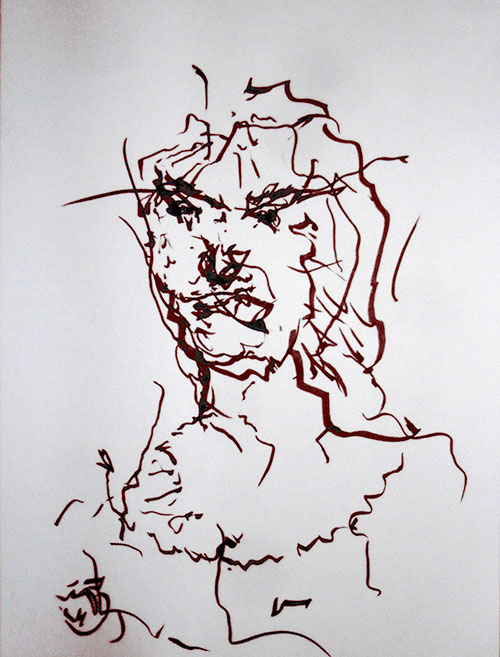
One fine late afternoon Tracey Emin awoke with a bad hangover only to be surprised to find drawings on the floor she didn’t remember making. She was also pleased with the execution of them, which was, some would say, so bad they are good. More than that, they were “brutally honest”. This incident was the impetus for a rather sensational idea for a series: get so drunk that you will have no memory of the night before, and produce images in that state to surprise yourself with. Minus the hangovers and other health risks, I can see the appeal of magically finding artwork one made, like treasure. Logically, much like a prize fighting boxing match, the health risks could be well offset by the money that would flow in from such a venture.
Two works from this series were subjected to the same dismal fate, thus I will share the second one before revealing what happened to them.
2) It’s All Do To My Tits
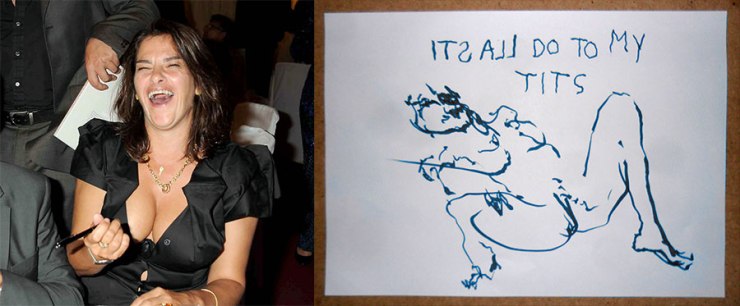
When the series was nearly complete, Emin had a friend over to share in part of the evening’s drinking, and that friend pointed out that there was a grammatical error in the painting above. Tracey laughed it off at first pointing out herself that the “s” is backwards in “its” obviously because she was so drunk, and everyone should know that, and besides the real point was that she’d questioned how much of the resurgence of her popularity coincided with a rather quality boob job she’d gotten. When her friend pointed out there was an additional error, which she was unable to locate, she became annoyed and called him a “pedant”. [I’m no one to condemn someone for grammatical errors, as you can probably find some in this post, as well as typos. Nevertheless it should be “due to my tits” and not “do to my tits”.] She set it on top of the self-portrait which was a pile, now of two, for reconsideration. Of the self-portrait she’d said, “I don’t mind looking like a tart, but I mind looking like the bride of the fucking elephant man”.
When she awoke the following noon, new drawings awaited her, but two of the previous drawings unfortunately didn’t make it. They’d been scribbled over, then torn to pieces, with some fragments ending up burnt relics in the ashtray, and others as floating islands in the toilet.
I find it interesting that the artist has no memory of creating nor destroying these two paintings.
Paul McCarthy:
1) Sigmund the Sea Monster Dong
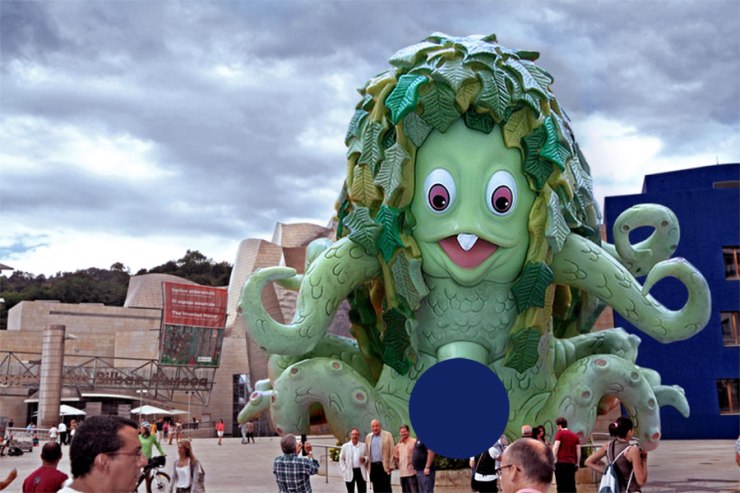
Paul McCarthy likes to upset people by grossing them out or just plain being offensive, and sometimes he succeeds all too well. The monumental inflatable sculpture above owes its inception to a one-liner he scrawled on a napkin: “Sigmund the Sea Monster DONG!” Paul sincerely believes there’s a really dark and ugly, Freudian, sexual undercurrent to the American dream of a two-car garage, sending the kids to college, Lassie, and a white picket fence. He has made a career out of desecrating the sacred icons of 20th century America, and particularly those of his own childhood. Usually this means shitting on something, buggering it, giving it a penis, or otherwise making it dirty and somehow infantile at the same time. He is one of the artists that believe that the more he shocks you the more real and legitimate he is. If you are offended, it’s always your shortcoming and never his.
This formula has made him rich and famous, but, it does have the downside of his art being really offensive to the general public, in which case it is not safe in a public space.
“Sigmund the Sea Monster DONG” was McCarthy’s most ambitious and expensive production to date, though most the difficulties were encountered by the company he hired to transform five words on a napkin into a mammoth inflatable sculpture, with anatomically “correct” additions. There were a lot of complications, and some trial and error before the final Sigmund was realized and inflated, on premises, at The Guggenheim Museum Bilbao in Spain.
When we strive to be as offensive and shocking as possible, we should be careful what we wish for. The 60 foot tall sculpture was inflated during the night and appeared like it had washed up onshore with the morning sun, before the museum opened, and, fatefully, before there were guards enough to protect it. A man – there isn’t clear enough surveillance footage, so we still don’t know who – punctured and slashed the sculpture with a large serrated knife, before running off. We do know that a man had purchased that knife along with other groceries and kitchenware at a nearby store, but the man was only remembered as “nondescript”. He’d apparently been walking home with his purchases, saw the sculpture where there hadn’t been one the day before, and was sufficiently upset by it that he saw fit to castrate Sigmund. In the end the sculpture was technically too difficult to resurrect.
When McCarthy was notified about what had happened, he said “I laughed so hard I pissed myself, and then I laughed at myself pissing myself, and then I just kept laughing and pissing.”
This is probably my favorite piece by McCarthy, possibly just because green is my favorite color and I like anything that comes out of the sea, especially monsters. Ironically, one of the only people that got to see it was the one who killed it.
2) Cock-blocking Fly
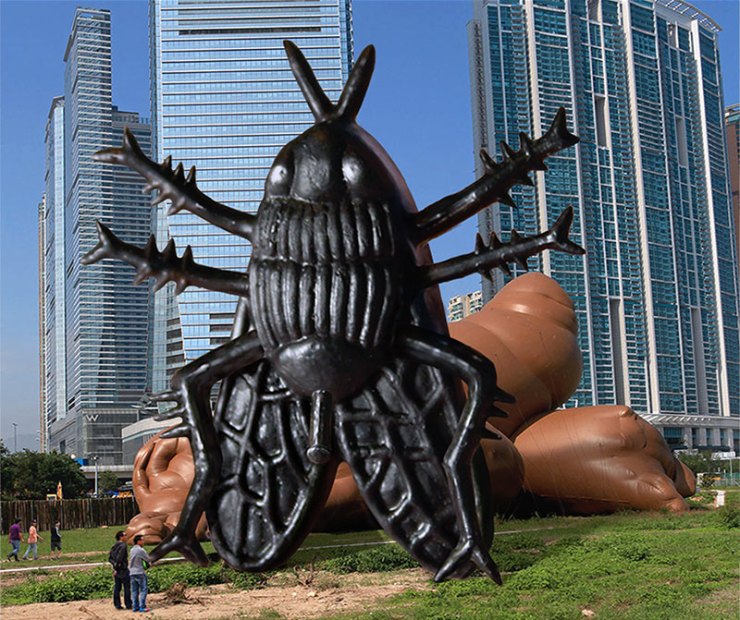
You’ve all heard that the definition of insanity is “doing the same thing over and expecting a different result”. Something like that. It’s also the definition of radical contemporary artist. As if McCarthy’s giant inflatable sculpture of dog shit, seen in the background above, wasn’t bad enough, he got an idea to create an obstacle or companion to it that would make it more powerful. So he thought. We aren’t supposed to understand the thinking of the more radical artists, in which case they wouldn’t be more radical.
In an interview McCarthy stated his aim: “I was thinking about if a fly had territory how would it act. How would you know if that was what it was doing? And then I thought if it were human it would stand guard like a bouncer, so I got the idea of making a bouncer fly. And then when I was making it I thought it was like it was cock blocking, so I had them give it a dick, or penis.”
I gather there is a fine line between offensive, stupid, and offensively stupid. McCarthy crossed that line as proud as a marathon winner. While people were fine with the giant dog turd – you can’t be too sensitive about it when dogs are making the real thing within a stone’s throw – they were not cool with what was termed “a racist depiction of a black man as a flasher”. A flasher was tasteless enough, but a racist depiction of one was too much. While the artist was adamant that he did not intend that reading of the work – he said, “I never even thought of it until you just said it just now” – he could not discount whether his unconscious did or not, because he would not be conscious of it if it did. The piece was quietly disassembled before it caused more offense.
Personally, I don’t see it as racist. The toy McCarthy modelled it after is black, like a lot of flies, and I think that’s as far as he thought about it. I do like its outstretched arms and just how weird it is. I’m kinda’ sorry to see this one go.
On Kawara:
Last Painting

On Kawara is most recognized for the “date paintings” he began in 1966. He essentially decided to make one painting a day of the date, on a monochrome surface, by hand. This didn’t work out practically, so he missed days, and nobody seems to mind this. More than 25,000 of these paintings are credited to his name, but there’s a little known story about why he stopped painting them.
Kawara lived in New York for roughly 50 years, and he’d already been making the paintings for decades when he finally decided to abandon them. He wrote a letter notifying his art dealers, explaining his decision, and also his intention to not produce the remaining paintings he was contracted to complete. His explanation was as follows:
“I am not the same person who started this project 35 years ago. My body does not contain a single atom from that period. Frankly, I cannot bear to make even one more of these paintings. The formula has become a prison sentence, and executing the paintings has become a debt. This morning over a cup of coffee I finally admitted to myself that I just wished I could stop. I said out loud, ‘Fuck it’. And I decided to make one last painting, which is the only one I could muster any enthusiasm for anymore, signaling my ending the series. It says, Fuck It.”
Exhibited precisely once, gallery owners quickly deduced the obvious, which they had instinctually feared: the final painting undercut the legitimacy of all the prior ones, including their monetary value. The red painting was simply removed until the gallery owners could figure out what the hell to do with it.
Kawara argued that it didn’t invalidate his previous work, but was a new inspiration. He’d said the old work was like larva and the new one was a butterfly, in which case it might be worth as much as all the other paintings combined. Until someone comes forward offering to pay that amount for it, I have a feeling this final work will remain hidden.
Incidentally, it’s probably my favorite work by Kawara. You can relate to a specific date on that specific date, but, you can always relate to “FUCK IT”.
Marcel Duchamp:
The Urinal

It’s important to know that this is Duchamp’s reworking of his infamous 1917 “The Fountain”, which was a urinal placed in an art exhibition.
Duchamp, despite all his popularity and accolades is seldom understood in the way he intended. He was an anti-artist who wanted to discredit art in the way he believed that religion had been discredited. One was never supposed to admire the physical beauty of his infamous readymade artworks. Quite the contrary, he selected them because they were neither attractive nor unattractive. The quality he sought was the flatly innocuous – the boring. He found nothing more offensive than when people called his work “beautiful”.
While Duchamp benefited significantly from the way his art was misconstrued, the philosopher in him was not pleased that his actual ideas were being inverted, and he’d become the poster boy for all that he abhorred. As he put it in one of his last interviews, “It’s as if I put a dirty sock on the… what do you call it? the… the altar in a church, and then people came to worship the dirty sock.”
Duchamp’s original urinal was intended to bring the real into the art gallery. It wasn’t like a painting: a window into the subjective mental universe of the artist. It was a factual, incontrovertible, base thing, without interpretation, without aestheticization, without aspirations of transcendence.
It was not even really important that one see it, because it was not itself inherently worth seeing. That was the point. It was a prank, and at the same time the idea that a prank could be art was born. This is also why the original urinal was lost or discarded. The gesture was important, not the mere artifact of the gesture. When people got it wrong and were eager to buy official copies of the urinal in a limited edition of a dozen, it was another prank on the art world, but this time it just fell into Duchamp’s lap. I’m sure he got a good laugh out of that.
Eventually, however, he stopped laughing and didn’t want to be immortalized as a prophet of a religion he not only didn’t believe in, but which disgusted him. His work was on pedestals in museums, and admiring audiences were stupidly gazing at it like it was Michelangelo’s David. What he wanted was for people to not stare at either in awe, but rather to accept the humble, plebeian, utilitarian THING as truth. Therefore he decided to place “The Fountain” back in the restroom where it would lose its exalted status and revert from a prince back into a warty toad. This time, without irony, he called it, “The Urinal”. It was an attempt to rescue the THING itself from the status of art and all the rhetoric surrounding it.
This was to be his final work, but as with On Kawara’s final piece, it ran the risk of undercutting the value of his prior work. It’s one thing to prank the art world when you are an unknown and there is no money involved – to say art is no better than a urinal, or something to be pissed on. It’s another to prank the art world a second time and say that the urinal is not the Holy Grail. Once you are canonized, and there is a fortune invested in your legacy, you are no longer allowed to overturn it, you can not say that a urinal is just a urinal.
The piece was exhibited without publicity or fanfare, with hired guests, largely to placate the aging artist. After the artist died within a year later the “The Urinal” was never seen or spoken about again.
In short, the Antichrist was crowned the Second Coming, and when he reminded the people it was a prank, it was too late.
Richard Prince
The Radical New Boring Shit
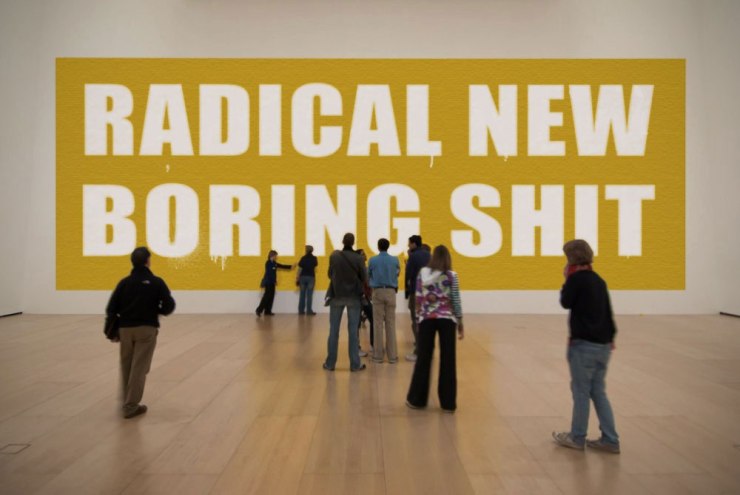
At first I was sure this was an attempt at self-mockery. Prince is known for doing short witty texts on canvas, in which case the witty text in question is calling itself boring shit. Perhaps the self-mockery makes it postmodern to the point which we can acknowledge something is boring shit and still easily think of it as “radical”. The easiest way to understand Postmodernism is that it’s a wink. It’s like, “we both know we’re kidding, or we’re full of shit, or both”. It’s a kind of stepping out of the role playing we do. It says, “Hey, we are both bullshitting, and we don’t need to pretend anymore.” And if you can wink again, it’s like the inverse of a dream within a dream. You can keep winking your way to enlightenment, probably.
But there’s another interpretation, far less obvious, and far more accurate. According to Duchamp, boring shit was radical. A comb, a urinal, a bottle rack, a snow shovel IS radically new. Thus, the witty text applies to itself, but it says that it is indeed radical because it is boring shit. It’s praising itself. And that is kinda’ funny, so there’s the real wit. It’s a dark, cynical wit.
Unfortunately for Prince his wit was too sophisticated, with too many layers of introspective self-reference for the average gallery-goer, who saw it as an attack on contemporary art, not a celebration of it’s self-awareness that it doesn’t have to pretend it isn’t bullshit.
THAT painting was NOT going to sell, and it pretty much pissed people off so much that they weren’t going to buy anything else by him, or anything else in the gallery. “RADICAL NEW BORING SHIT” ended up in the dumpster.
I kinda’ like the idea of being self aware enough to admit something is boring shit and we don’t have to pretend it’s otherwise. I just prefer being self aware enough to admit when something is interesting shit and we don’t have to pretend it’s otherwise. It’s also not “radical new”, it’s “new radical”. Radical hasn’t really changed since Duchamp’s Fountain, which was a century ago, so, “radical” primarily just applies to a style of art. So, you have your Impressionism, Pop Art, Color Field Art, Abstract Art, and it’s all Radical Art… It doesn’t really apply to something that’s surprisingly new. It’s the same old surprise over and over. But, it’s an OK surprise, I guess.
Honestly, I just like this painting because it makes me laugh. And maybe that was his intent. I like a good joke. Why not paint it?
Jean-Michel Basquiat:
Portrait of Andy Warhol

Art buying and selling are starting to take place in the secret bowels of the internet – the “dark web”. It is a space for the intrepid, where one can buy drugs, firearms, and priceless art. Most of us are clueless about how to access it and want little to do with it, finding the above-ground internet challenging and dark enough, thank you. A taste for vice and disposable income in the tens of millions sometimes goes together, in which case it might be advantageous to negotiate deals in private among insiders in an exclusive setting.
This little gem emerged briefly in a shady corner of the dark web following the recent sale of a Basquiat painting for $110 million at a Sotheby’s auction, and then as quickly disappeared. The portrait of Warhol was painted the same year as the other painting, but has remained in private hands for decades due to Warhol’s dislike of it, and his making Basquiat promise to destroy it, which he couldn’t bear to do. [For more details on the story behind the painting, see my article here.] For this reason it has been kept in some apparently clueless friends’ storage, until the front page news of the latest sale woke them up to the fact that they were sitting on a gold mine. The portrait of Warhol had already received bids over $60 million when it momentarily blipped on public radar, and the estimated value is $150 million.
Sometimes a work of art is so precious that it’s like Nigel Tufnel’s special guitar in Spinal Tap, you aren’t even allowed to look at it. Looking at it is for the select few, by Gad. Except that computer savvy individuals know how to hack into less rigorously private groups and retrieve images.
Vincent Van Gogh:
Self-Portrait with Cut Ear
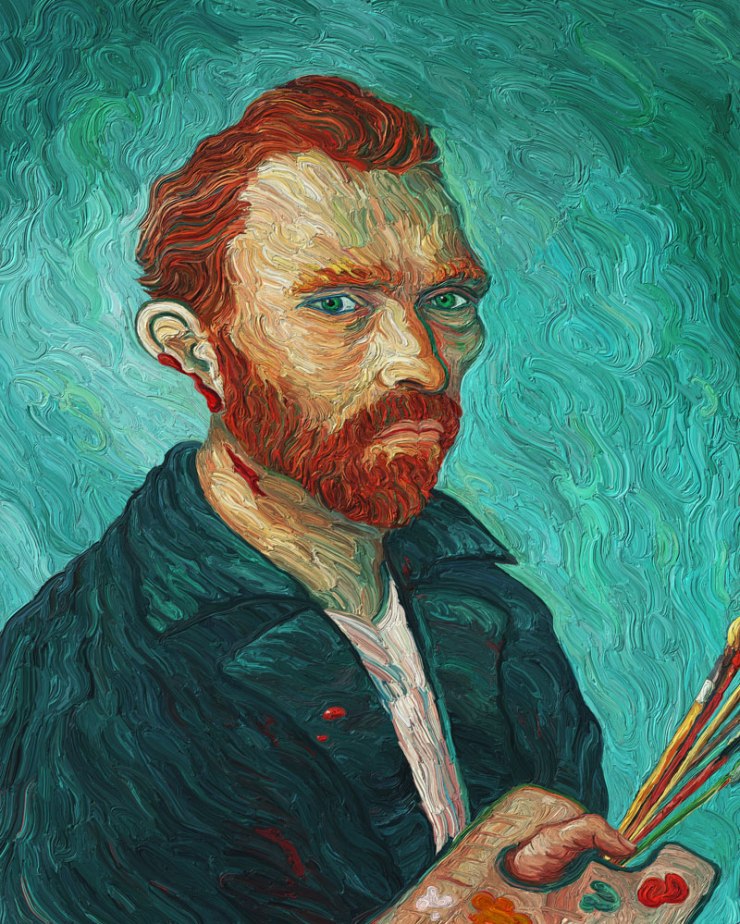
This is one of Van Gogh’s last and wildest creations, said to be furiously painted in one sitting during a psychotropic state brought about by overindulgence in Absinthe and extreme psychological turmoil. Not to mention agonizing pain. But what we see in that bewildering state is clarity cutting through it all in his piercing gaze. Only Van Gogh could paint in such a condition, and only he could paint fast enough. The legend behind this painting is that it was done – it HAd to be done – after his ear was cut and before he was found unconscious and severely bleeding the following morning.
There are legitimate questions concerning whether he cut his own ear or whether Gauguin cut it with a saber, which he was seen brandishing that evening, before he fled Arles that same night. Some argue persuasively that Vincent merely claimed the injury was self-inflicted to protect his friend from imprisonment and not being able to continue painting, and that Vincent might have felt responsible for antagonizing Gauguin in the first place. Scholars argue that the painting indicates a slash across the ear and into the neck, which would be very difficult and daunting to inflict on oneself, but would be incidental in a probably accidental swipe of a sword. If I hadn’t already accepted that Vincent mutilated himself, I think the other explanation is more plausible. Another reason given is that Vincent was sending a message to Gauguin, to show who was the stronger person, who had more will power and endurance, who was not to blame. It could be for that and for friendship, in which case he was setting a good example of generosity and fortitude. But people prefer to think he cut his own ear because he was a nut, uh, and that’s why his paintings are good.
That his paintings are that good is self-evident, allow me to interject here. Thinking of him as crazy just helps people make a mental leap to where they can appreciate his work. His paintings aren’t great because he was crazy, as people think, his paintings are crazy because he was great. You can quote me on that.
Today we are accustomed to blood and gore – think Game of Thrones – in which case this image may not shock us, but Van Gogh’s doctor, Dr. Gatchet, thought it was too harrowing and hid it away in his own personal collection, partly to preserve the reputation of his painter friend. He wanted Van Gogh to be remembered for his luminous sunflowers and humble portrayal of peasants, and not for the worst night of his life. Another interpretation is that the painting was hidden to protect Gauguin, at least initially.
With or without the painting, there are still paintings in public collections in which Vincent has a bandaged ear, and Vincent is a legend as much for cutting off his own ear, as people believe, as he is for his transcendent paintings.
The painting remains in the private collection of descendants of Dr. Gatchet, following his wishes, and is not available for public viewing. I think they should give it to the Van Gogh museum in Amsterdam, but, were it to go on the market, I believe it would easily break all auction records, and museums can’t afford to compete. It would probably end up in Qatar, or somewhere else where most of us would never get to see it. For now we have to content ourselves with a single reproduction.
The art world that appears on our monitors, or even in our museums, is an edited version, like a Jigsaw Puzzle short a few pieces. Sometimes the culprit is a chance event, sometimes it’s a crass manipulation designed to make or maintain proceeds, and sometimes it is believed that we can’t handle the art. I hope these missing works from public collections help a little to complete your art puzzle.
~ Ends
Note: If it isn't perfectly obvious to the average viewer, and I would think it would be, especially if you are familiar with my art criticism and art work (especially my Photoshop work),than I suppose I should elucidate that all content and images in the article were created by yours truly. This is a conceptual, hypothetical, experimental form of art criticism, or even an art prank of sorts, not entirely unlike something Duchamp would do. Well, not really, but it is pranking the art world and rethinking it.


Brilliant!!!
LikeLiked by 1 person